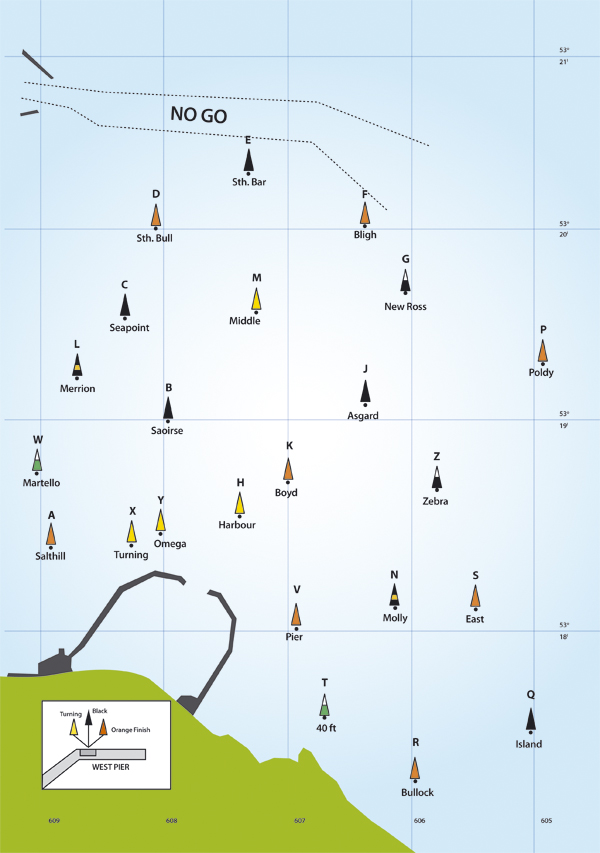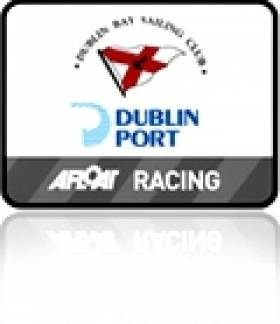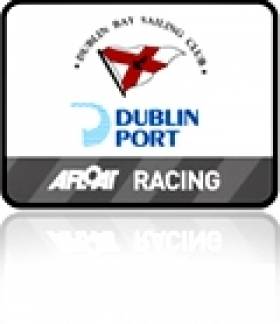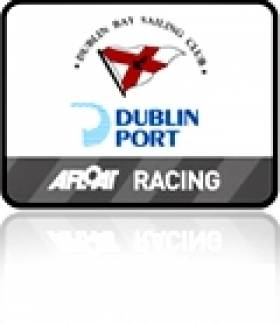Displaying items by tag: DBSC
Light Airs No Obstacle in DBSC
As wide a selection of Irish dinghy classes as you could imagine struggled around a light air Dublin Bay Sailing Club course this evening but in spite of its feeble strength the north westerly breeze held and allowed everything from elderly IDRA 14s to ultra modern Olympic 49ers to finish the sailing course on Scotsmans bay.
In the PY class Peter Craig won sailing a Laser, second was G Ryan/J MacAree in a 470 and third was Tim Goodbody in a Laser.
The biggest spectacle in tonight's race though was the consideration given by the Sea Lynx Car ferry that waited patiently to exit Dun Laoghaire harbour as a mix of dinghy and keelboat competitors cleared the mouth of the harbour with as much speed as they could muster.
Racing eventually ended in a rain shower at 8.30pm, Results are below:
DUBLIN PORT Dublin Bay Sailing Club Results for 11 MAY 2010
CRUISERS 1 - 1. Jalapeno (Dermod Baker et al), 2. Something Else (J.Hall et al), 3. Lula Belle (Liam Coyne)
CRUISERS 2 - 1. Katanca (C. Ennis/B O'Connor), 2. Free Spirit (John O'Reilly)
CRUISERS 3 - 1. Cacciatore (Anne O'Callaghan et al), 2. Asterix (J.Counihan/F.Meredith), 3. Pamafe (Michael Costello)
CRUISERS 4 - 1. Aslana (J.Martin/B.Mulkeen), 2. Maranda (Myles Kelly)
FIREBALL - 1. Elevation (N.Colin/M.Casey), 2. Incubus (S Oram), 3. Reality Check (Marie Barry)
IDRA 14 FOOT - 1. Doody (J.Fitzgerald/J.Byrne), 2. Squalls (Stephen Harrison), 3. Dunmoanin (Frank Hamilton)
MERMAID - 1. Kim (D Cassidy), 2. Lively Lady (G O'Neill & M Hanney)
PY CLASS - 1. Peter Craig (Laser), 2. G Ryan/J MacAree (470), 3. Tim Goodbody (Laser 1)
RUFFIAN 23 - 1. Alias (D.Meeke/M.McCarthy), 2. Icicle (C & J Murray), 3. Shillelagh (J.Caldwell/D.Barber)
SIGMA 33 - 1. White Mischief (Timothy Goodbody), 2. Pippa lV (G.Kinsman/K.Blake/M.O'Brien)
Good Spinnaker Work at a Premium on Dublin Bay
Keeping the DBSC sailing spinnaker flying was at a premium tonight for the 17 keelboat classes who inched around Dublin Bay in north easterly winds that rarely blew over 6 knots. The One Design fleets raced to forty foot mark under spinnaker before finishing in Scotsmans Bay against an ebbing tide at the Mac Lir Committee Boat. In the Ruffian class good spinnaker work by the crew of Diane ll (Bruce Carswell) enabled the Royal St. George Yacht to out wit club mates Ruff Nuff (D & C Mitchell), Third was Paramour (Larry Power). The bulk of the fleet were back in harbour before dusk but at least one SB3 sportsboat was towed home in the dark at 21.30 as the breeze dropped altogether on the bay.
DUBLIN PORT Dublin Bay Sailing Club Results for 6 MAY 2010
BENETEAU 31.7 Echo- 1. Dies Irae (Patrick Rowan), 2. Thirty Something (Gerry Jones et al), 3. Magic (D.O'Sullivan/D.Espey)
BENETEAU 31.7 - 1. Magic (D.O'Sullivan/D.Espey), 2. Thirty Something (Gerry Jones et al), 3. Extremity (Paul D'Alton)
CRUISERS 0 Echo - 1. Tsunami (Vincent Farrell), 2. Lively Lady (Derek Martin)
CRUISERS 1 Echo - 1. Axiom (M.O'Neill), 2. Errislannan (Patrick Kirwan), 3. Joker 11 (John Maybury)
CRUISERS 1 - 1. Joker 11 (John Maybury), 2. Something Else (J.Hall et al), 3. Errislannan (Patrick Kirwan)
CRUISERS 2 Echo - 1. Peridot (Y Charrier et al), 2. Helter Skelter (Adrienne Jermyn), 3. Bendemeer (Gerald Kinsella)
CRUISERS 2 - 1. Peridot (Y Charrier et al), 2. Bendemeer (Gerald Kinsella), 3. Free Spirit (John O'Reilly)
CRUISERS 3 - 1. Hard on Port (Flor O'Driscoll), 2. Supernova (K.Lawless et al), 3. Two Step (Ross Doyle)
CRUISERS 3 Echo - 1. Lindos (Clive Martin), 2. Jiminy Cricket (Mona Tyndall), 3. Saki (Paget McCormack et al)
CRUISERS 4 - 1. Ghrazel (Charles Pearson), 2. Aslana (J.Martin/B.Mulkeen), 3. Maranda (Myles Kelly)
DRAGON - 1. Diva (R.Johnson/R.Goodbody), 2. Zinzan (Daniel O'Connor et al), 3. Puca (P.Burke/R.Henry)
FLYING FIFTEEN - 1. Fflogger (Alan Dooley), 2. Snow White (Frank Burgess), 3. Fifty Somethings (David Mulvin)
GLEN - 1. Glenmarissa (F.Elmes/W.Higgins), 2. Glendun (B.Denham et al), 3. Glenshane (P Hogan)
RUFFIAN 23 - 1. Diane ll (Bruce Carswell), 2. Ruff Nuff (D & C Mitchell), 3. Paramour (Larry Power et al)
SB3s - 1. No Name (Gordon Judge), 2. Bom Chickawahwah (John O'Driscoll), 3. Mephisto (S & T Bourke)
SHIPMAN - 1. Poppy (Peter Wallis et al), 2. Twocan (David Freeman), 3. Curraglas (John Masterson)
SIGMA 33 - 1. Rupert (R.Lovegrove/P.Varian), 2. Popje (Ted McCourt), 3. Leeuwin (Henry Leonard et al)
SQUIB - 1. Lola (Frank Whelan), 2. Little Demon (Marie Dee), 3. Buzz Lite (G.O'Connor/B.Foster)
WHITE SAIL CRUISERS Echo - 1. Afternoon Delight (Michael Bennett et al), 2. Persistence (C. Broadhead et al), 3. Arwen (Philip O'Dwyer)
WHITE SAIL CRUISERS - 1. Arwen (Philip O'Dwyer), 2. Act Two (Michael O'Leary et al), 3. Persistence (C. Broadhead et al)
Hamilton's 'Dunmoanin' wins IDRA 14 DBSC Race
North Westerly winds and volcanic ash may have caused havoc for airline passengers today but the ten knot breezes preoved perfect for Tuesday night Dublin Bay Sailing Club racing on Dublin Bay. Frank Hamilton's IDRA 14 dinghy Dunmoanin was the winner from Stephen Harrison's Squalls. Full sailing results here.
DUBLIN PORT Dublin Bay Sailing Club Results for 4 MAY 2010
CRUISERS 1 - 1. Jalapeno (Dermod Baker et al), 2. Something Else (J.Hall et al)
CRUISERS 3 - 1. Pamafe (Michael Costello), 2. Rattler 2 (Austin Whelan), 3. Grasshopper 2 (K & J Glynn)
CRUISERS 4 - 1. Maranda (Myles Kelly), 2. Aslana (J.Martin/B.Mulkeen)
FIREBALL - 1. Reality Check (Marie Barry), 2. Goodness Gracious (Louise McKenna), 3. Red Eye (Barry McDevitt)
GLEN - 1. Glencorel (B.Waldock/K.Malcolm)
IDRA 14 FOOT - 1. Dunmoanin (Frank Hamilton), 2. Squalls (Stephen Harrison)
MERMAID - 1. Tiller Girl (J.O'Rourke), 2. Jill (P.Smith/P.Mangan)
PY CLASS - 1. G Ryan/J MacAree (470), 2. J Toomey/N Byrne (Laser Vago), 3. Richard Tate (Laser)
RUFFIAN 23 - 1. Shillelagh (J.Caldwell/D.Barber), 2. Alias (D.Meeke/M.McCarthy), 3. Icicle (C & J Murray)
SIGMA 33 - 1. White Mischief (Timothy Goodbody), 2. Pippa lV (G.Kinsman/K.Blake/M.O'Brien)
SQUIB - 1. Tais (Michael O'Connell), 2. Periguin (N.Coakley/J.Redahan)
Persistence Pays off in DBSC White Sail Fleet
Westerly winds gusting to over 10 knots provided ample breeze for the first Dublin Bay Sailing Club Thursday race of the season. Colin Galavan's Design Security was the winner in a large turnout of SB3s and Charles Broadhead's Persistence was the winner of the White Sail Cruisers on ECHO handicap. A full set of sailing results is published here.
DUBLIN PORT Dublin Bay Sailing Club Results for 29 APRIL 2010
BENETEAU 31.7 Echo- 1. Attitude (D.Owens/T.Milner), 2. Magic (D.O'Sullivan/D.Espey), 3. Prospect (Chris Johnston)
BENETEAU 31.7 - 1. Magic (D.O'Sullivan/D.Espey), 2. Attitude (D.Owens/T.Milner), 3. Prospect (Chris Johnston)
CRUISERS 0 Echo - 1. Tsunami (Vincent Farrell), 2. Lively Lady (Derek Martin)
CRUISERS 1 Echo - 1. Jalapeno (Dermod Baker et al), 2. Something Else (J.Hall et al), 3. Another Adventure (Darragh Cafferkey)
CRUISERS 1 - 1. Jalapeno (Dermod Baker et al), 2. Joker 11 (John Maybury), 3. Something Else (J.Hall et al)
CRUISERS 2 - 1. Jawesome 11 (V.Kennedy/M.Dyke), 2. Peridot (Y Charrier et al), 3. Red Rhum (J Nicholson)
CRUISERS 2 Echo - 1. Red Rhum (J Nicholson), 2. Peridot (Y Charrier et al), 3. Jawesome 11 (V.Kennedy/M.Dyke)
CRUISERS 3 Echo - 1. Gung Ho (G & S O'Shea), 2. Lady Rowena (David Bolger), 3. Jiminy Cricket (Mona Tyndall)
CRUISERS 3 - 1. Gung Ho (G & S O'Shea), 2. Supernova (K.Lawless et al), 3. Cries of Passion (Bryan Maguire)
FLYING FIFTEEN - 1. Fifty Somethings (David Mulvin), 2. Deranged (C.Doorly), 3. Flyer (Niall Coleman)
GLEN - 1. Glendun (B.Denham et al), 2. Glencorel (B.Waldock/K.Malcolm), 3. Glenshane (P Hogan)
RUFFIAN 23 - 1. Ruff Nuff (D & C Mitchell), 2. Ruffles (Michael Cutliffe), 3. Diane ll (Bruce Carswell)
SB3s - 1. Design Security (Colin Galavan), 2. Blue Bird (Cathy McAleavy), 3. Sin Bin (Barry O'Neill)
SHIPMAN - 1. Poppy (Peter Wallis et al), 2. Whiterock (Henry Robinson), 3. Curraglas (John Masterson)
SIGMA 33 - 1. Popje (Ted McCourt), 2. Rupert (R.Lovegrove/P.Varian), 3. Enchantress (Michael Larkin et al)
SQUIB - 1. Aquabats (Brendan Fogarty), 2. Absolutely Fabulous (N Kennedy/P Reilly), 3. Anemos (Pete & Ann Evans)
WHITE SAIL CRUISERS Echo - 1. Persistence (C. Broadhead et al), 2. Afternoon Delight (Michael Bennett et al), 3. Lucy O (Aonghus O hEocha)
WHITE SAIL CRUISERS - 1. Persistence (C. Broadhead et al), 2. Windshift (R O'Flynn et al), 3. Arwen (Philip O'Dwyer)
Familiar Names at Front of 2010 DBSC Fleet
Winds gusting to 26–knots ushered in the 2010 Dublin Bay Sailing Club Summer season this afternoon for a combined fleet of up to 300 yachts sailing on Dublin Bay. Inspite of new course configurations and some new race marks there were plenty of familiar names on the results sheets after a full racing programme was completed. Outgoing Royal Irish YC Commodore Tim Goodbody - who also designed DBSC's new courses - beat incoming Commodore Henry Leonard in the Sigma 33 class. Consistent performers David Gorman and Chris Doorly in the Flying fifteens were in their usual position for the first race of four windward leeward legs but they slipped to third in race two following a boat handling error downwind. Next DBSC races are on Tuesday and Thursday evenings.
DUBLIN PORT Dublin Bay Sailing Club Results for 24 APRIL 2010
BENETEAU 31.7 Echo- 1. Attitude (D.Owens/T.Milner), 2. Extreme Reality (P.McSwiney/E.O'Rafferty), 3. Bluefin Two (M & B Bryson)
BENETEAU 31.7 - 1. Attitude (D.Owens/T.Milner), 2. Prospect (Chris Johnston), 3. Bluefin Two (M & B Bryson)
CRUISERS 1 Echo - 1. Something Else (J.Hall et al), 2. Indecision (Declan Hayes et al), 3. Jalapeno (Dermod Baker et al)
CRUISERS 1 - 1. Something Else (J.Hall et al), 2. Jalapeno (Dermod Baker et al), 3. Joker 11 (John Maybury)
CRUISERS 2 Echo - 1. Peridot (Y Charrier et al), 2. Bendemeer (Gerald Kinsella), 3. Jawesome 11 (V.Kennedy/M.Dyke)
CRUISERS 2 - 1. Peridot (Y Charrier et al)
CRUISERS 3 - 1. Asterix (J.Counihan/F.Meredith), 2. Pamafe (Michael Costello), 3. Gung Ho (G & S O'Shea)
CRUISERS 3 Echo - 1. Pamafe (Michael Costello), 2. Asterix (J.Counihan/F.Meredith), 3. Jammie Dodger (J.H & D.O'Neill)
CRUISERS 4 - 1. Rascal (K.Burke/S.Milner), 2. Maranda (Myles Kelly)
FLYING FIFTEEN - 1. Hy5ive (D & S Gorman), 2. The Gruffalo (Keith Poole), 3. Fifty Somethings (David Mulvin)
FLYING FIFTEEN Race 2- 1. The Gruffalo (Keith Poole), 2. Snow White (Frank Burgess), 3. Hy5ive (D & S Gorman)
GLEN - 1. Glendun (B.Denham et al), 2. Glencorel (B.Waldock/K.Malcolm), 3. Glenluce (D & R O'Connor)
RUFFIAN 23 - 1. Ruffles (Michael Cutliffe), 2. Shannagh (S.Gill/P.MacDiarmada), 3. Ruff N Ready (Ann Kirwan et al)
SHIPMAN - 1. Jo Slim (J.Clarke et al), 2. Whiterock (Henry Robinson), 3. Poppy (Peter Wallis et al)
SIGMA 33 - 1. White Mischief (Timothy Goodbody), 2. Leeuwin (Henry Leonard et al)
SQUIB Race 2- 1. Femme Fatale (Joe O'Byrne), 2. Little Demon (Marie Dee), 3. Waverider (F.Gaynor/T.Bryan)
SQUIB - 1. Waverider (F.Gaynor/T.Bryan), 2. Femme Fatale (Joe O'Byrne), 3. Anemos (Pete & Ann Evans)
WHITE SAIL CRUISERS - 1. The Great Escape (P & D Rigney), 2. Effex 11 (Alan Rountree), 3. Windermere (J & S Taylor)
Dublin Bay Sailing Club Unveil New Courses Tomorrow
Dublin Bay Sailing Club (DBSC) has unveiled a range of new courses for its new summer sailing season, the biggest in the country, that starts tomorrow. Arising out of congestion on Thursday's evening races the club has been motivated to separate its blue and red fleets that total nearly 300 boats. Hon Secretary Donal O'Sullivan says there is very little sign of any recessionary drop off among its 1700 members, an indication, were it needed, there is still high demand for local racing on the capital's waters.
There are 17 keelboat fleets, each racing at different speeds, so separating classes is no easy job.
The first of the current phase of course changes happened in 2001 when DBSC acquired a committee boat, MacLir, that has given great flexibility to course changing afloat. Then in 2003 there was a major overhaul and now for next Saturday's first race, building on the experience of the intervening years, there is a 2010 model.
Two new marks have been introduced, Merrion in Seapoint Bay and Molly near Scotsman's Bay to combat the problem, other marks have been moved. (see chart over the fold).
The Blue fleet (Cruiser classes 0, 1,2,3, 31.7s Sigmas and White sail boats) will race in the upper northern part of the racing area on Thursdays.
The overall shape or pattern of the courses remains the same. As before, there will be blue, red and green divisions, with alternating West Pier Hut and MacLir starts.
"The big change is that in order to limit as much as possible the intermingling of different fleets, the blue fleet will tend to race most of the time in the upper, northern section of the racing area while the red fleet will race in the lower, southern section" says new commodore Tony Fox.
On the dinghy course, there are exciting changes as well. This year, besides the usual triangular or windward/leeward courses race officers will be able to select a trapezoid course. This could pose interesting problems for mark-layers but the dinghy organisers have, not unexpectedly, anticipated this. There have been training courses, marks will be laid using GPS, and the team have access to a dedicated website with training videos.

Dublin Bay Sailing Club (DBSC)
Dublin Bay Sailing Club (DBSC) is the largest yacht-racing organisation on the Irish east coast
You'll find all the latest Dublin Bay Sailing Club News here.
With sixteen hundred elected members, the Club provides regular weekly racing for upwards of 360 yachts, ranging from ocean-going forty footers to small dinghies for juniors. It prompted the question by Afloat.ie's WM Nixon Is Dublin Bay Sailing Club (DBSC) The Most Effective Sailing Organisation in the World?
The most remarkable thing about Dublin Bay Sailing Club (DBSC) is not that it is one of Europe's biggest, Ireland's busiest or that 2013 marked the club's 132nd season. It's more the fact, in the current climate, that the club – which has no club house - appears to have escaped the ravages of the 'R' word. In 2016, the club embarked on a new sponsorship deal.

Dublin Bay Sailing Club's Committee Vessel, the Mac Lir. Photo: David O'Brien
In a shot in the arm for bay sailing, there is no reported drop in DBSC entries at a time when individual waterfront clubs are struggling to hold members.
A total of 390 boats across 15 fleets are preparing to come to the line off Dun Laoghaire for the first race of the DBSC summer series on Tuesday week (April 24th).
The biggest DBSC fleet is Cruisers III a mix of 37 types to include quarter tonners, J24s and eight or nine Sonatas.
The SB3 Sports boat maintains its fleet of 34 and therefore its place as the biggest one design class on the bay.
Formed in 1884 with humble ambitions for small boat racing in the area, DBSC has remained true to these roots but grown with the popularity of sailing here and become the de facto club racing organisation for the capital's dinghies and cruisers; organising racing five nights per week from April to October.
Since the marina arrived in 2001 the club has also organised winter fixtures, thereby giving itself a year round remit.
It organises club racing for all four of Dun Laoghaire's waterfront clubs plus an increasing number for those who have opted out of yacht club membership to sail instead from the town's public marina.
The increase in numbers though, particularly on Thursday evenings, led to growing pains and last season an experiment to split the massive fleet removed congestion at certain mark roundings proved successful.
The red fleet and blue fleet divisions remain but there are more improvements for Thursday nights slated for this season with the introduction of a second committee boat on the water.
Inevitably the move means the end of a Dublin Bay institution, for Thursday's nights at least. The West Pier starting hut, in operation since 1968, will disappear except for use in very heavy weather.
The club's own MacLir committee boat will be servicing the Blue Fleet in the northern section of the racing area, The Royal Irish Yacht Club's Spirit of the Irish vessel will service the red fleet in the south-east section.
Other changes afloat have required re-drafting of courses and some re-location of marks. Omega mark has moved from its original position not far from the West Pier to serve as a hub for the Red Fleet marks which, with the addition of a new Bay Mark, form a natural circle. Similarly, Middle mark becomes the hub of the Blue Fleet circle.
Consequently, some shifting of other mark positions has ensued‚ the only radical change is that of Poldy, which was situated too close to the shipping lane for comfort; it will now be stationed roughly between East and Island Marks. Martello Mark is now redundant.
The Club operates from Dun Laoghaire, a major marine recreational centre and ferry port six miles to the south of Dublin. The members are drawn for the most part from the four local yacht clubs but visiting yachts can participate in racing if they complete the Club's temporary yacht entry and membership form and pay a small fee. Visiting yachts may also compete in the Club's Cruiser Challenge, held every year over the third weekend of August.
Apart from a Starter's Hut on Dun Laoghaire West Pier, the Club possesses no premises; moorings – the usual onshore facilities are provided by the local yacht clubs. The new Dun Laoghaire Marina, situated in the north-western side of the Harbour, now accommodates a growing number of racing yachts.
Racing usually starts at the end of April and continues up to the end of September. Mid-week races for keelboats takes place on Thursday evenings, from late April to the end of August. Keelboat crews and dinghy sailors race on Tuesday evenings. On Saturday afternoons (April to September) racing is provided for both keelboats and dinghies. Keelboat races start either on fixed lines on the seaward side of Dun Laoghaire West Pier or from a committee boat stationed not far from the harbour mouth.
Courses are designed around fixed marks in Dublin Bay, in an area of nearly 40 square miles, extending from Salthill and Seapoint on the western side of Bay to the Burford Bank on the east. All races finish at the Club's fixed lines at the West Pier but may be be shortened at the committee boat if necessary.
On Saturdays afternoons, two classes (Dragons and J24s) race on Olympic-style courses, joined occasionally by the Ruffian and Glen classes.
Dinghy racing takes place on Olympic-type courses on Saturdays in Seapoint Bay, on the northwest side of the West Pier and, on Tuesday evenings in Scotsman's Bay, on the seaward side of Dun Laoghaire East Pier. On certain Saturdays in June and July, the Club makes way for the annual one-day regattas of the the four local yacht clubs.
Correspondence to: Hon. Secretary, DBSC, 72 Clonkeen Drive, Foxrock, Dublin 18. Tel: 01 289 8565
Have we got your club details? Contact us via the homepage to get involved
© 2016 www.afloat.ie

































































